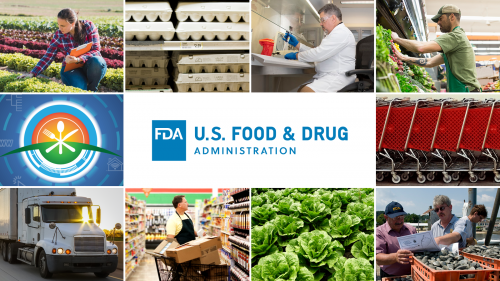What FDA’s Foods Program Achieved in 2020 to Protect Consumers and the Food Supply

By: Frank Yiannas, Deputy Commissioner for Food Policy and Response
At the dawn of 2021, I find myself looking back at what the U.S. Food and Drug Administration’s Foods Program was able to accomplish in 2020, a historic year marked by unprecedented challenges in both our personal and professional lives.
I’m struck by how tirelessly our team members have worked together to help ensure the continuity of the food supply chain and to help keep food workers and consumers alike safe during the COVID-19 pandemic. Their commitment has not wavered in a time when we’re all dealing personally with the impact of the pandemic on our families, schooling our children from home and taking care of elderly parents.
I’d like to share some of the 2020 accomplishments that really stand out to me (among many, many others).
Food Program’s COVID-19 Response
This is Number One in my book. Early in the pandemic, amid that first rush of fear and concern, the FDA played a critical role in reassuring consumers that there is no evidence that the virus that causes COVID-19 is transmitted by food or food packaging. As restaurants closed, we provided temporary labeling and packaging flexibility to support a food industry struggling with imbalances of food in the marketplace. We assessed the human and animal food supply and worked to maintain both. We worked with the Centers for Disease Control and Prevention (CDC), the U.S. Department of Agriculture and the Occupational Safety and Health Administration, as well as with our state partners, to develop and share resources to help food workers stay safe – recognizing that worker safety and supply chain continuity are two sides of the same coin.
New Era of Smarter Food Safety Blueprint
Despite the challenges of the pandemic, in 2020 we released the New Era of Smarter Food Safety blueprint that lays out how we will build on the FDA Food Safety Modernization Act (FSMA) over the next decade to continue modernizing our approaches and creating a more digital, traceable, and safer food system. Work has continued throughout the pandemic to implement the initiative, and on October 26, we conducted a First 100 Days of the New Era of Smarter Food Safety webinar to inform industry, government, academia, and consumer groups about our efforts, drawing more than 2,600 registrants. In light of the pandemic, we realize that the goals outlined in the blueprint are more important than ever. These include an accelerated need for enhancing traceability, exploring the use of remote inspections, addressing safety vulnerabilities for foods ordered online and supporting food safety culture.
2020 Leafy Greens STEC Action Plan
Between 2009 and 2018, the FDA and CDC identified 40 outbreaks of Shiga-toxin producing E. coli (STEC) with a confirmed or suspected link to fresh leafy greens. In the fall of 2019, the FDA stated we could and would do more. Therefore, in March of 2020, we released the 2020 Leafy Greens STEC Action Plan, outlining a holistic body of work in three areas: prevention; response; and research gaps. The action plan has resulted in more collaborative work being done by the FDA and stakeholders to advance the safety of leafy greens than ever before and it has been widely praised by many, including the California Department of Food and Agriculture.
Employing Artificial Intelligence
We are conducting a pilot program to learn the added benefits of using artificial intelligence (AI), specifically the machine learning that makes it possible to rapidly analyze data, in the screening of foods imported into the U.S. In August, the agency announced the results of a proof-of-concept to validate the approach we’re taking. The results are exciting, demonstrating that machine learning can almost triple the likelihood that we will identify a shipment containing potentially contaminated products. With funding and the support of this initiative by Congress, work on this pilot will continue in 2021, with AI being applied to field conditions. In the 21st century, with data becoming one of our most powerful tools to fight foodborne illnesses, leveraging tools such as AI to strengthen our predictive capabilities could be a game-changer for food safety.
Proposed Food Traceability Rule
As many of you know, I’ve often been quoted as saying a lack of traceability is an Achilles heel in today’s modern food system. That’s why I’m so pleased to report that this past September the FDA issued its Proposed Rule for Food Traceability. This rule is mandated by FSMA and we describe it in the New Era blueprint as the first step to harmonize the key data elements and critical tracking events needed for enhanced traceability. Over the past few months, we’ve had three public meetings to discuss this critical measure and are accepting public comments through the Federal Register.
Agricultural Water
In 2020, the FDA announced a new protocol for the development and registration of antimicrobial treatments for preharvest agricultural water, such as the water used in farm irrigation systems. The protocol was developed through a collaboration with the U.S. Environmental Protection Agency (EPA). Companies can now use data developed under this protocol to support their EPA registration of products that can treat agricultural water against foodborne bacteria. This could provide farmers with a useful tool to help protect the safety of their produce, like romaine lettuce and other leafy greens.
Additionally, we will be proposing revisions to the agricultural water requirements under the FSMA Produce Safety Rule that are designed to address certain implementation challenges while still protecting public health.
Outbreak Investigations
As part of our commitment to continuous improvement, in 2020, we made several enhancements to our foodborne outbreak investigation processes.
We conducted a root cause investigation into 2019 outbreaks of E. coli O157:H7 infections tied to romaine lettuce that found an outbreak strain in a fecal-soil composite sample taken from a cattle grate less than two miles upslope from a produce farm with fields tied to the outbreaks as well as other STEC strains found closer to where romaine lettuce crops were grown. These findings suggest that a contributing factor has been the proximity of cattle to the produce fields.
We also conducted a root cause investigation into a multi-state outbreak of Cyclospora infections in the summer of 2020 that found the parasite in the surface water of a canal near the farm suspected of being the source of contaminated produce. Our scientists pioneered ways to detect the parasite in produce and water that were employed in this outbreak investigation.
As part of our commitment to transparency, we now publish and update weekly a new outbreaks investigation table. This lists information on all foodborne outbreaks as soon as the FDA begins an investigation, before there’s a public health advisory or food recall.
All in all, 2020 shows impressive work on the foods front, and I have no doubt it has prevented illnesses and made a difference in allowing safe and available food to make its way to consumers’ households in a time of great need. And we are committed to doing more in the years ahead, beginning with 2021.

